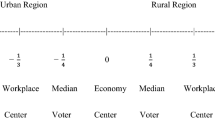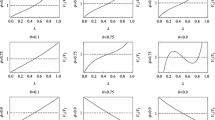Abstract
This paper presents a model of interurban and intraurban location that is used to consider the impact of wage taxes on housing and labor markets in a metropolitan area. The focus of the paper is to examine the differences in the regional impact of commuter wage taxes (source-based wage taxes) and residents-only wage taxes (residence-based wage taxes). The model illustrates that suburban land rent and wages can be affected in equilibrium by central city policies and that the mix of public goods (that is, whether they benefit households or firms) as well as those who bear the burden of financing them has implications regarding land values and shifts in relative population and production. Understanding such linkages is important in the creation and analysis of regional economic policy.
Similar content being viewed by others
References
Blomquist, M. C.; Berger, M. C.; Hoehn, J. P. “New Estimates of Quality of Life in Urban Areas,”American Economic Review, 78, 1, March 1988, pp. 89–107.
Braid, R. “The Spatial Effects of Wage or Property Tax Differentials and Local Government Choice Between Tax Instruments,”Journal of Urban Economics, 51, 3, May 2002, pp. 429–45.
——. “A Three Input Model of the Spatial Effects of a Central-City Wage Tax,”Journal of Urban Economics, 54, 1, July 2003, pp. 89–109.
Crampton, G. “Local Government Structure and Urban Residential Location,”Urban Studies, 33, 7, August 1996, pp. 1061–76.
Darren, T.; Wheaton, W. “Intra-Urban Wage Variation, Employment Location, and Commuting Times,”Journal of Urban Economics, 50, 2, September 2001, pp. 338–66.
De Bartolome, C.; Ross, S. “Equilibria With Local Governments and Commuting: Income Sortingvs. Income Mixing,”Journal of Urban Economics, 54, 1, July 2003, pp. 1–20.
Gyourko, J.; Tracy, J. “The Importance of Local Fiscal Conditions in Analyzing Local Labor Markets,”Journal of Political Economy, 97, 5, October 1989, pp. 1208–31.
——. “The Structure of Local Public Finance and the Quality of Life,”Journal of Political Economy, 99, 4, August 1991, pp. 774–806.
Haughwout, A. “Central City Infrastructure Investment and Suburban Land Values,”Regional Science and Urban Economics, 27, 2, April 1997, pp. 199–216.
——. “Regional Fiscal Cooperation in Metropolitan Areas: An Exploration,”Journal of Policy Analysis and Management, 18, 4, Fall 1999, pp. 579–600.
Hettler, P. “Central City Fiscal Conditions and Suburban Sprawl and Urban Decline,” Thesis, Ph.D. University of Pittsburgh, December 1998.
——. “Spillover Effects of Local Fiscal Policy,”Atlantic Economic Journal, 29, 4, December 2001, pp. 1–14.
Hoehn, J. P.; Berger, M. C.; Bloomquist, M. C. “A Hedonic Model of Interregional Wages, Rents, and Amenity Values,”Journal of Regional Science, 27, 4, November 1987, pp. 605–20.
Hoyt, W. “Market Power of Large Cities and Policy Differences in Metropolitan Areas,”Regional Science and Urban Economics, 22, 4, November 1992, pp. 539–58.
Johansson, B.; Klaesson, J.; Olsson, M. “Commuters' Non-Linear Response to Time Differences,”Journal of Geographic Systems, 5, 3, November 2003, pp. 315–29.
Ladd, H.; Bradbury, K. “City Taxes and Property Tax Bases,”National Tax Journal, 41, 4, December 1988, pp. 503–23.
Mattey, J. P. “Evolution of Quality of Life in the U.S.”FRBSF Economic Letter, 96, 26, September 13, 1996.
McMillen, D. P.; Singell, L. D. “Work Location, Residence Location, and the Intraurban Wage Gradient,”Journal of Urban Economics, 32, 2, September 1992, pp. 195–213.
Roback, J. “The Value of Local Urban Amenities: Theory and Measurement,” Thesis, Ph.D., University of Rochester. May 1980.
——. “Wages, Rents, and the Quality of Life,”Journal of Political Economy, 90, 6, December 1982, pp. 1257–79.
Rosen, S. “Wage-Based Indexes of Urban Quality of Life,” in Mieszkowski, Peter and Mahlon Straszheim, eds.,Current Issues in Urban Economics, Baltimore, MD, USA: Johns Hopkins University Press, 1979, pp. 154–67.
Sasaki, K. “Interjurisdictional Commuting and Local Public Goods,”Annals of Regional Science, 25, 4, December 1991, pp. 271–85.
Savitch, H. V.; Collins, D.; Sanders, D.; Markham, J. “Ties that Bind: Central Cities, Suburbs and the New Metropolitan Region,”Economic Development Quarterly, 7, 4, December 1993, pp. 341–57.
So, K.; Orazem, P.; Otto, D. “The Effects of Housing Prices, Wages, and Commuting Time on Joint Residential and Job Location Choices,”American Journal of Agricultural Economics, 83, 4, November 2001, pp. 1036–48.
Voith, R. “Capitalization of Local and Regional Attributes Into Wages and Rents: Differences Across Residential, Commercial, and Mixed-Use Communities,”Journal of Regional Science, 31, 2, May 1991, pp. 127–45.
Author information
Authors and Affiliations
Rights and permissions
About this article
Cite this article
Hettler, P.L. Regional impact of commuter wage taxes. Atlantic Economic Journal 32, 191–200 (2004). https://doi.org/10.1007/BF02299437
Issue Date:
DOI: https://doi.org/10.1007/BF02299437




